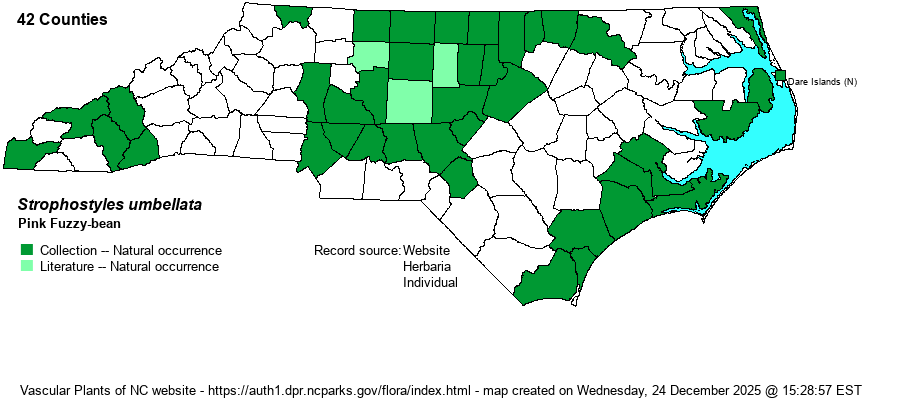| Author | (Muhlenberg ex Willdenow) Britton | |
| Distribution | Scattered over the whole state, but there are currently large gaps in the range. Very scarce in the northern Mountains and far western Piedmont, and in a zone across the central and western Coastal Plain.
This is somewhat Southeastern species, ranging north to NY and IA, south to central FL and eastern TX -- a smaller range than with S. helvola. This species is generally absent from the central Appalachians south into western NC and eastern TN.
| |
| Abundance | Frequent to common in the central and eastern Piedmont. Frequent to locally common in nearly all coastal counties. Oddly scarce elsewhere, except can be fairly common in the southwestern Mountains. | |
| Habitat | This is one of a large number of legumes in NC that favor dry or sandy openings. It oocurs along dry woodland borders, dry powerline clearings, sandy places in open woods, and in other dry or sandy disturbed ground. It is not normally found on sand dunes as is S. helvola. As with that species, however, considering its common habitats, it is mysteriously scarce to absent over considerable parts of the NC range, in all three provinces. | |
| Phenology | Blooms from June to September, and fruits from August to October. | |
| Identification | This species and S. helvola are quite similar, both being scattered across the state and both generally similar in appearance. Each is a slender trailing or weakly twining vine, reaching to 3-5 feet long. Each has trifoliate leaves; in this species the 3 leaflets are ovate to narrowly ovate (to almost oblong), with no side lobes. The leaflets are about 1.5-2 inches long but generally about 1/3 to 1/2 as wide, seldom more than 3/4-inch wide. In S. helvola, there are usually two rounded side lobes, often only weakly developed, and the terminal leaflet is generally more than 1 inch wide (thus some leaflets are about as wide as long). Each has scattered clusters of just a few flowers in each, on very long and often erect stalks that reach 6-10 inches long, well beyond the leaves. The flower is usually bright rose to purple-rose, but can be pink to even whitish, about 1/2-inch across, with the standard upright and quite rounded, that gives each flower a circular shape. There are some characters in the bracts (bracteoles) of each species, but the main differences between the two are the leaflet shape -- an un-lobed set of leaflets and a narrower terminal leaflet (mostly 3/4-inch wide) in S. umbellata versus mainly tri-lobed in S. helvola, which makes the leaflets wider, especially the terminal leaflet (which is more than 1 inch wide). For those who may be interested, S. umbellata is a perennial species whereas S. helvola is an annual. This species should be relatively easy to encounter on walks in uplands in the central and eastern Piedmont, and also in some sandy or other dry places in coastal counties, though not in coastal (i.e., salt-water) habitats. Note that there are quite a few trailing legumes with 3 leaflets; the two Strophostyles leaflets tend to be larger than many (like Galactia) or a shinier and darker green (looking almost evergreen) than most others. Some observers may have to see flowers or fruit to be sure they are looking at a member of this genus. | |
| Taxonomic Comments | None
| |
| Other Common Name(s) | Perennial Sand-bean, Perennial Fuzzy-bean, Pink Wild-bean, Perennial Woolly-bean, Climbing Twisted-pea. As with S. helvola, there are many common names used by various references, none even close to unanimity. Older referecnes generally called both as "xxxx Wild-bean", but as there are hundreds of beans (legume species), some in other genera named as wild-bean, it is best that a different group common name be in usage. The group name of "fuzzy-bean" seems to be of recent usage, but it is distinctive one. | |
| State Rank | S4 | |
| Global Rank | G5 | |
| State Status | | |
| US Status | | |
| USACE-agcp | FAC link |
| USACE-emp | FACU link |

